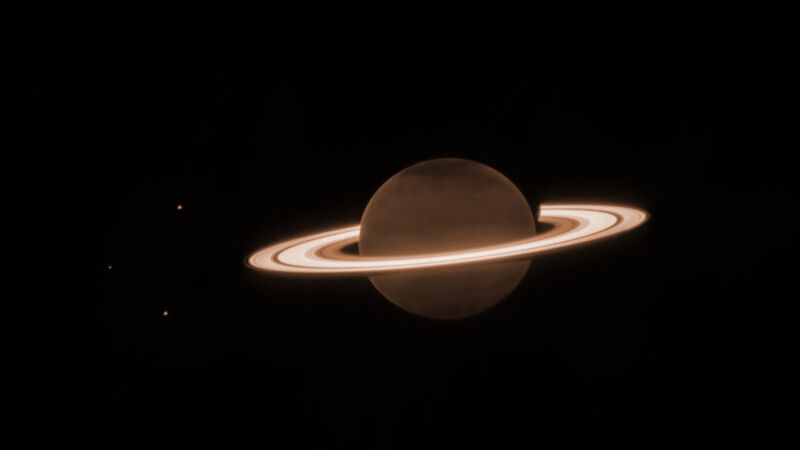
The James Webb Space Telescope has observed Saturn for the first time, completing a family portrait of the Solar System’s ringed planets nearly a year after the mission’s first jaw-dropping image release.
Webb’s near-infrared camera took the picture of Saturn on June 25. Scientists added orange colour to the monochrome picture to produce the image released Friday.
The picture shows Saturn’s iconic icy rings shining around the disk of the gas giant, which appears much darker in near-infrared due to the absorption of sunlight by methane particles suspended high in the planet’s atmosphere.
Webb pointed its 21.3-foot (6.5-meter) gold-coated mirror toward Saturn as part of an observing program to test the telescope’s ability to detect faint moons. The observations included several deep exposures of Saturn that astronomers are still analyzing to probe the planet’s fainter rings and search for undiscovered moons.
There are 146 known moons in orbit around Saturn, ranging in size from larger than the planet Mercury to the size of a sports arena, more than any other planet in the solar system, according to NASA.
“Any newly discovered moons could help scientists put together a more complete picture of the current system of Saturn, as well as its past,” NASA said in a blog post released with the new Saturn image.
Three of Saturn’s moons appear to the left of the planet in Webb’s view: Dione, Enceladus, and Tethys are visible as points of light. Each is about the size of a large US state.
Recent observations of Enceladus using Webb’s near-infrared spectrograph instrument revealed a jet of water vapor extending more than 6,000 miles (10,000 kilometers) into space, 20 times the diameter of the moon. Scientists say Enceladus is one of the most promising locations in the solar system to search for signs of life because it harbors a water ocean underneath a global ice shell.

NASA’s Cassini orbiter flew by Enceladus numerous times before its mission ended in 2017. Cassini spotted similar water plumes erupting through fissures in Enceladus’s ice sheet and flew through the jets to sample the particles coming from the moon’s deep ocean.
The Cassini spacecraft captured views of Saturn with higher resolution than Webb, but with Cassini’s mission over, Webb is the primary tool scientists will use to continue studying Enceladus and Saturn for at least the next decade.
There’s currently no mission on the books to visit Enceladus. NASA’s robotic Dragonfly mission is scheduled for launch toward Saturn in 2027, but it will focus on exploring Titan, Saturn’s largest moon.
The first scientific images from Webb were released nearly one year ago, showing the promise of the $10 billion mission to see deeper into the Universe than ever before. Observations within the Solar System are just part of Webb’s scientific portfolio, alongside scientific topics such as studying the formation of the first galaxies after the Big Bang and the search for planets around other stars that might contain the ingredients for life.
Webb science teams previously released spectacular views of the Solar System’s other ringed planets—Jupiter, Neptune, and Uranus—along with its first observations of Mars.
Stationed about a million miles from Earth, Webb is unable to observe the Moon, Mercury, or Venus because they are too bright or too close to the Sun.



3175x175(CURRENT).thumb.jpg.b05acc060982b36f5891ba728e6d953c.jpg)
Recommended Comments
There are no comments to display.
Join the conversation
You can post now and register later. If you have an account, sign in now to post with your account.
Note: Your post will require moderator approval before it will be visible.